What you need to do this off season with your program
As the new year approaches, the new season will soon be only 3 months away. As a result, most players will be preparing physically for next season, doing extra training in their own time outside of club training. This is definitely a good thing – as this is basically the new baseline – in other words, if your aren’t doing extra training, you will be falling behind, as most players do it these days. So it is important to maximise the benefit or the result that you get from the extra training that you are performing, because not all strength training and running based training is the same (in terms of quality of benefit), and additionally, it certainly isn’t always a case of ‘more is better.’
So lets have a quick look at 10 things that you can do to ensure your off season and pre season is effective in setting you up for next season.
1. Identify what your personal goals for your game are – and have a specific plan or method via which to achieve these.
What are your goals for your game in matches? And then more specifically, what is it that you would like to work on in terms of particular movements or tasks? There are numerous improvements in physical performance that player’s strength train in order to improve;
- More explosive acceleration
- Powerful and efficient deceleration and changing of direction
- Higher vertical leap (off 1 leg or 2 – both of which require different exercise progressions)
- More upper body strength to push off an opponent in a marking contest or ground level contest
- Speed & agility
- Improvement in functional tackling strength
- Injury prevention


Improved tackling ability and a more powerful vertical leap off 1 leg are just 2 of the many various improvements in physical performance that can be achieved with a functional and correctly periodised weight training program.
This short list just scratches the surface in terms of the types of physical tasks that you may be looking to improve in order to improve your overall performance. Every player is different, has different goals, levels of experience, levels of ability and of course injuries and physical limitations.
But the key point here is to identify what your top 1-3 goals are, and then have a plan in place specifically over the 3 months leading in (and then of course beyond that too) for how you will work on improving these things. 'Just getting better overall' is a recipe for going no where. There is nothing worse than putting in extra hours for week after week with randomized general training, and seeing no benefit what-so-ever because what you were doing wasn’t focused specifically on these goals.
2. Drop the bodybuilding focus - and the ‘putting on size’ emphasis with these techniques.
This is something that we cover in far more detail elsewhere, and so will not take up too much space here. But don’t fall into the trap of ‘size’ being the focus of strength sessions – especially if this size is gained with standard bodybuilding methods. This training has no place in the program of someone training for a complex athletic event like football. But again, read more here.
3. Ensure you are training (strength, power and running-based) include movement in all 3 planes.
Most everyday movements will require movement, or at the very least some stability, in all 3 planes. As footy is a very dynamic part of life, it would make sense that this point is particularly important.
Footy requires movements in all 3 planes of movement, only with the added factor of more complex movements, executed at a breakneck speed, all whilst other people around you are trying to flatten you. Therefore, it is important to condition and strengthen in all 3 planes of movement. So firstly, what are the 3 planes?
The 3 planes of movement (or motion) are;
-Frontal Plane: The frontal plane divides the body into front and back, and all movements in this plane are movements along this plane. The easiest movements along this plane to picture are known as abduction (limbs moving further away from the body) and adduction (limbs being brought in closer to the body.) The most well known example of an exercise like this would be a lateral shoulder raise (dumb bell out to the side.) The easiest movement to think of in footy would be moving sideways in one direction and explosively pushing off 1 leg and moving in the opposite direction when trying to get around an opponent in front of you. Indeed, this movement in footy actually requires movements in all three planes, but the sideways movement and push off the leg is very much frontal plane dominant. So a lateral lunge would be a good functional exercise to think of that mimics this movement, and is in this plane. Step ups require pelvic stability in the frontal plane, whilst most of the movement itself is sagittal. Cable Woodchops are also another good example to think of – the sideways movement of them are very much in the frontal plane.

- Sagittal plane: The sagittal plane divides the body into right and left, and the primary movements in this plane are the up and down movements known as flexion and extension. This is the most commonly exercised plane in just about all strength training programs. There are plenty of common examples of exercises in this plane, but a squat or a bicep curl are 2 of the most commonly known ones. Deadlifts are another common functional example, but as mentioned, most of the commonly performed strength exercises will fall into this category.
- Transverse Plane: The transverse plane is also sometimes referred to as the horizontal plane, and divides the body into upper and lower halves. All movements in this plane are rotational in nature, and occur in all the joints throughout the body. This is the least exercised plane, and is hardly worked at all in most routines. This is the plane of motion in which the most common injuries occur, such as ACL tears, hamstring strains and ankle sprains. A cable woodchop pattern would be the best-known movement that fits this plane, although woodchops also provide for movement in the other 2 planes as well. Tackling would be the easiest type of footy movement to visualise this transverse plane.
When considering the 3 planes of movement, refer to the pictures below, and imagine a big sheet of glass splitting the body in half, and imagine your body and limbs having to move along the glass whilst performing a particular movement. This is how to determine which plane/s you are moving in.

The reason that this is so relevant to a strength training program as it applies to footy is because most strength training programs that are being done around the place involve exercises and routines that are very sagittal plane dominant. This is despite the fact that footy certainly isn’t sagittal plane dominant. Kicking isn’t a sagittal dominant movement (but requires stability in all 3 planes, particularly around the hips) and has a large rotational (transverse) component (hence why leg extenstions do not have a very high carryover to kicking at all), tackling certainly isn’t sagittal dominant, and requires a great deal of rotational movement (so therefore a lot of transverse plane here), changing of direction requires stability and movement in all 3 planes, and even something as seemingly simple or trivial as pivoting on one leg as you change direction will send a great amount of rotational force through the knee joint, which so often is simply trained in the sagittal plane. In other words, to properly prepare the knee (as just one example) for the rigors of footy, strengthen it with movements in all 3 planes.
Key Point: Movements and tasks in footy occur in all 3 planes of motion at the same time – so condition accordingly
Just a quick extension as an example; You may be thinking ‘I do squats and deadlifts for my legs, they are functional’, and indeed these 2 exercises have become synonymous with ‘functional training’ in recent times. And they are great exercises. However, despite being fantastic full body exercises that work your whole body from head to toe, and require your core and stabiliser muscles to control the weight as well as require you to provide for the movement, these 2 exercises are performed almost entirely in the sagittal plane.
Another little interesting fact is that the majority of non-contact injuries that occur in sports occur in the transverse and frontal planes, yet the number of exercises that are done to train in these 2 planes are almost completely inverse, or opposite (that is the majority of strength training is done in the sagittal). A very interesting relationship to say the least. In some texts and papers, the number of non-contact injuries occurring in these 2 planes are up around the 80% mark, whilst the number of exercises or time spent training in the sagittal plane is also up around a similar level. In fact, I would estimate that 90% of strength training I see done at the gym are exercises done in the sagittal plane. This figure is obviously made worse as a result of all the bodybuilding or useless ‘mirror training’ that occurs by people only interested in the look, but even the athletes that I see training are only marginally better in terms of the 3 planes, despite the fact that their exercises are more movement focused.
4. Approach training with an emphasis on movement and ability, rather than ‘muscles’
This ties in a little with the earlier point on bodybuilding and putting on useless size, but just comes from a different angle.
The brain recognises movement, not muscles. The fitness industry is so damn focused on muscles (particularly how impressive they look), and all the garbage in magazines is so focused on ‘this exercise for this muscle’, that most people are surprised, even shocked, to hear me say that muscles themselves, are only an afterthought in terms of getting stronger and moving better. And by that, I don’t just mean that the look of muscles is an afterthought when training for athleticism, but rather muscles in general. You see, explaining things in terms of certain muscles used and trained in an exercise is an easy way of getting to understand what areas and functions we are focused on improving, however at the end of the day, the actual muscle tissue on its own is relatively irrelevant to improvement. Muscles are simply sacks of flesh. Muscles are controlled by the nervous system, and the nerve fibers that innervate them, and any developments in strength and coordination and movement are all in fact developments in the nervous system.
Lets keep this fairly simple and practical. The nervous system when we are referring to exercise consists of the brain, the spinal chord and all the nerves (major and minor fibers) that branch out from it. These are responsible for all movement commands. No movement, be it a quick reflex or a maximal effort contraction of a muscle, occurs without a command being sent from the brain down through the spinal chord out through the nerves to the muscle/s. This is a very broad and simplistic explanation of a very sophisticated process, and indeed there are instances where this process differs, like certain instances for example, where certain reflex actions originate at the spinal chord, rather than the brain. But the key point is that all movement is controlled by this system, muscles have nothing to do with the command, they simply act out the command.
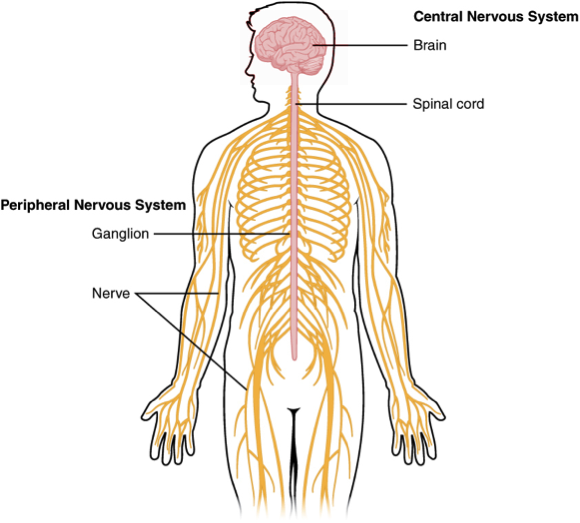

The picture on the left shows the central nervous system consisting of the brain and spinal chord branching out to our peripheral nervous system, consisting of the nerves themselves. The picture on the right shows these nerves and subsequent fibers (the yellow parts) innervating the muscles of the leg. Whenever you run, kick or jump it is this system controlling it, not your muscles, and the quality and power with which you will perform these tasks are determined by the quality of the program in the nervous system, not by the look and size of your muscles.
Following on from this point, the nervous system acts like a ‘living computer software’ program of sorts, where movements are stored in the central nervous system ‘memory’ and refined over time, depending on how they have been developed, and what qualities have been developed. This may be strength, speed, stamina (as a few examples) in any one of a number of unlimited patterns, and they are improved by continuously being trained in specific ways. And so whenever you call on your body to perform a certain task, your central nervous system fires a previously stored program to perform this task, and every time you perform it, you are refining and hopefully (depending on the quality of the movement program you are firing) improving it.
By recognising movement patterns, the nervous system is able to operate a much more quick and efficient system. Just think of how inefficient and slow the body would be if your brain had to consciously think of every single individual muscle involved in each movement in order to perform a task. Even something as simple as walking would be a slow process, let alone complex neural tasks like sprinting, kicking and tackling. Suffice to say, the more complex a task is, the more complex training required to properly prepare the nervous system for the task, and this is a key point to remember when conditioning for footy, because there is no more neurally-challenging sport in terms of all the movements and athletic tasks and challenges on the system required.
So for example, having a big chest from doing hundreds of machine chest presses and lots of bench presses doesn’t meant that you will be better at pushing off an opponent, just as doing hundreds of bicep curls doesn’t mean that you will be a better tackler. Why? Because this is a muscle focus, rather than a movement focus. These thoughts are a common mistake made as a result of training being so muscle focused. But remember, the brain recognises movement, not muscles.

Yes you use your biceps in a tackle, but you also use them together with your hips, legs and entire torso in any one of a number of patterns. You may like looking at your biceps while you flex them doing a curl, but performing heavier curls and for more and more reps will not transfer over to any use in a game of footy, especially for a task like tackling.
Yes the bench press is a good upper body pushing exercise (a seated chest press on a machine is useless just for the record) that will give you the potential to get better at pushing of your opponent, but if other exercises aren’t done to specifically link your upper body through your core to your legs to be able to push your opponent while standing, this strength will not carryover. After all, when you are pushing off an opponent, you are not lying down, you are not supported by a bench, and you are trying to coordinate a few more tasks than just pushing a bar. What sounds more demanding on your nervous system;
- Lying on a comfortable bench and pushing a bar up off your chest
Or
- Trying to keep your balance with most of your weight on 1 leg, whilst pushing into an opponent, who is trying to push you off you center of gravity, whilst you watch and try to judge the flight of the ball flying through the air towards you?
One more important thing to realise here is that muscles have various different functions and roles to play depending on the movement or task being performed, or the particular position or situation that they are in. The fact is, a hamstring may be used as a ‘knee flexor’ (which is how most anatomy textbooks list the function of the hamstrings) in some instances such as kicking a ball, but what are the hamstrings doing on the other leg? Certainly not flexing the knee, but rather being used to both extend the hip as well as assist in proving stability and balance to the hip on the other leg (if all things are functioning as they should.) So you can see a muscle can provide many functions depending on what is needed, and it may be a prime mover in one instance and then function primarily as a stabiliser in another instance (and in all 3 planes of movement remember, not just sagittal as is the case with a basic hamstring curl), and as such, training an individual muscle in an isolated function is useless, as this training will have no use or carryover if that muscle is called upon to do other things as it will be.
So just remember – ‘movement’ not ‘muscle.’
5. Compound exercises – Minimal isolation & Maximising the limited time at your disposal
Isolation exercises have their place, especially if you need to rehab a particular joint, muscle or body part. Rehabilitation is beyond the scope of this article, simply because every case is unique and must be treated accordingly. However, just on rehabilitation and the isolation of muscles in the rehabilitation process I will say this, after you have isolated a muscle, you must then integrate it back into the whole chain of muscles as well as movement patterns. The failure to do this properly is a big problem that I see regularly in ‘rehab’ programs. Remember, the brain recognises movements not muscles.
Back to the main point. By this stage after reading the last couple points, you probably have a good understanding of the main reasons why strength training for footy should be based predominantly around compound exercises involving many muscles and muscle groups and almost eliminate all isolation exercises like bicep curls and shoulder abductions. You may love the way your arms look in the mirror when you do them, but if you want to stop kidding yourself and focus fully on training to be a footballer, don’t waste your time doing these, or at least only perform them after all the important functional work that will be of benefit has been completed. Aside from these reasons to drop isolation training and focus on the compound stuff;
- Far more carryover in training adaption relevant to match day
- Training movements not muscles
- Challenging your nervous system more
- Being far more challenging from a work rate and conditioning point of view too.
There is also the added bonus of being far more time efficient with training. You likely work a full time or part time job, or are a student on top of playing footy, and on top of having a family and social life and all the other things that go with everyday life, and do not have the luxury of being a full time professional athlete. And lets not forget the actual club training and match days. So you likely will not have an endless amount of time to dedicate to your strength training program for footy. Therefore it makes sense to pick exercises where you are getting as much work done in as little time as possible. So it should be obvious to want to pick exercises that are achieving the greatest possible result in the limited amount of time that you have at your disposal. Time spent doing bicep curls and tricep-pulldowns and sit-ups is time wasted. You must prioritise!
One final added benefit of performing compound exercises over the inefficient isolation stuff, as outlined by Tudor Bompa in Periodization Training for Sports, is that these exercises also create a far greater workload for the cardio-respiratory system as well, meaning that you are also getting a lot more ‘cardio’ conditioning when performing these exercises. This benefit of this for training for footy goes without saying.
6. Integrate everything you do into a standing environment.
Footy is a game played on your feet. Well you can be in contests on hands and knees and be on the ground when tackled obviously but remember the old sayings ‘keep your feet’ and ‘if you’re on the ground you’re out of the game’. Footy is played on your feet, and as a result, a priority must be placed on exercises and training movements standing. Yes there is a place for functional exercises that don’t strictly fit this bill, such as bench press and various core exercises where you are on hands and knees or closer to the ground in some way. However, these skills and strength must then be integrated into a functional use by performing exercises which transfer these abilities to a standing environment, as this is where you will have the greatest functional carryover for footy, since footy is played on your feet.
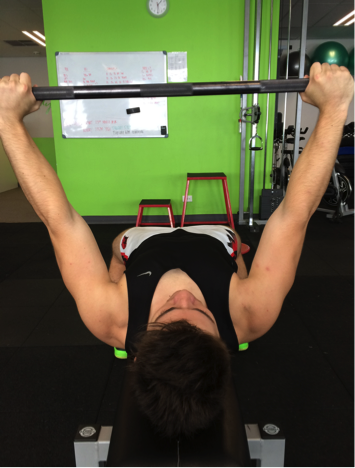
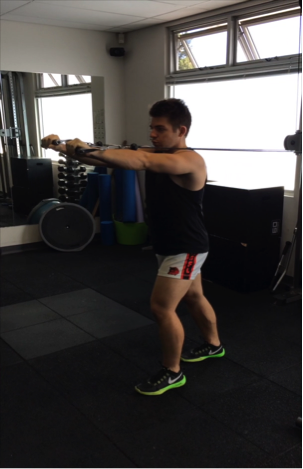
For example, you have been doing bench press to develop your upper body strength in this fairly isolated position on the bench. Good so now lets take this potential strength for footy, and integrate it into strength that can actually be used in a game – lets now train ourselves doing a pushing movement in a standing position, requiring core stability and strength and the transfer of energy from the ground up through our legs, through the core and then finally up through our torso, chest and arms. You will have to leave the ego at the door here though, as you will not move anywhere near as much weight in this position as you will on your bench press. And why might that be? Because it is a hell of a lot more complex, requires a hell of a lot more whole body strength, stability (particularly core) and coordination, and as a result, is far more transferrable to the footy ground.
The same applies to core based exercises – core exercises on the floor and with swiss balls and TRX straps are great ways to specifically hit the core musculature, but this then must be transferred with appropriate training, linking the core with full body standing movements. Core activation and strength is task specific – meaning that just because your inner-unit fires correctly when you do exercises on the floor, doesn’t meant that it will fire when on the feet and landing or laying a tackle (when you need it firing the most.) It is not uncommon for someone to be a champion of core strength and stability on the floor, yet have a core that does not fire appropriately in standing tasks when most needed to protect the spine.
Key point – standing!
7. Generalised motor program compatibility, and similar relative timing in movements
Ok technical sounding point in the title, but very simple to understand when it is applied in plain English. Remember a motor program is basically like a movement program in our ‘software’. This point basically says that for an exercise to be functional for football, it must train very similar movement patterns to those that are performed on match day. This would hopefully seem obvious by this point, but please read on, it may not be as obvious as it sounds. For example, a squat would be a similar motor program to a jump off 2 feet, a step up would be a similar motor program to a jump off 1 foot, as these require not only similar movements and in similar positions, but also, similar relative timing of the muscles involved. Or in other words, the muscles involved in the movement are contributing at the same relative time (to each other) as they are in the associated movements in a match situation. However do not be tricked into thinking that a leg press would have a similar carryover to the double leg jump as a squat does, because a leg press and a vertical jump are not similar generalised motor programs and a leg press and a vertical jump do not have similar relative timing in movements. A leg press is minimal in terms of carryover for movements in football. For starters, a leg press virtually isolates your knee joint; there is very minimal hip involvement at all because it is largely locked in place (many people mistakenly believe that there is hip involvement in the leg press). Ok great, so we have already eliminated the primary joint responsible for jumping (the hip) from the movement, but then to top it off, we are also sitting down, or lying on a 45-degree angle. These are positions and movements that you will never find yourself in and never be required to perform in a game of footy, and therefore, there is no carryover via a generalised motor program as there is with a squat.
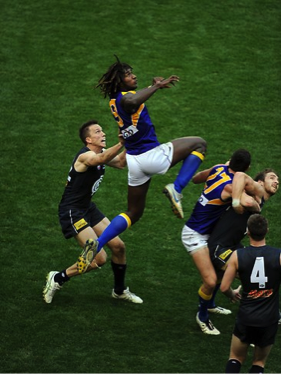

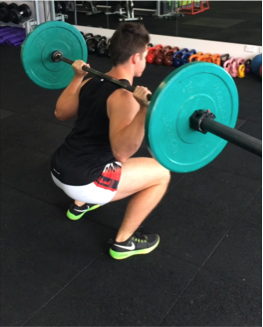
Jumps are regularly performed in games of footy – off 1 leg or 2, and certainly standing. Therefore set a good baseline of functional strength with exercises that require you to perform similar movements, in a standing position, off both 1 leg or 2, that will require you to train your body through a very similar movement patters, such as squats and step ups. And please don’t waste any more time on the leg press - I think the guy below is actually sleeping (hard to tell on this exercise).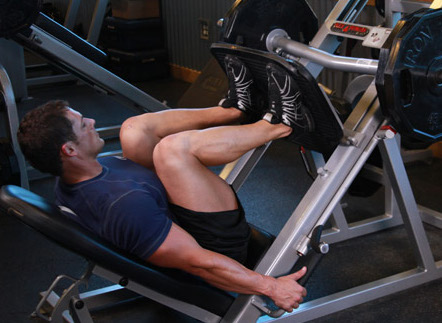
8. Don’t base your running-based training around steady state runs like 5km runs.
The most common form of running that amateur and junior footy players out there do is the standard 5m or 10km runs to ‘get some km’s in the legs’ or ‘lay a foundation’ or to ‘be ready for the start of pre-season.’ So when someone says ‘I’m going for a run’, that is quite literally what they are doing. However this is a very inefficient use of time and effort, and your time and effort would be best spent changing this up slightly.
Think about a game of footy – a 2 hour period requiring all sorts of physicals tasks and challenges – tackling, running, kicking, pushing, pulling, jumping etc. Of course running will not be too much assistance in improving any of these tasks bar running. We already know this and that is where footy specific strength training comes into its own. But of course footy is a game based around locomotion, or running. So of course we go running to improve our ability to run in a game of footy. But lets take a closer look at the running in a game of footy.
When running in a game you will jog 30 meters, then accelerate and break into a sprint, decelerate and change directions 90 degrees and then reaccelerate again and sprint another 50 meters, before then stopping and walking for 20 seconds (potentially….depending.) Then in an instant you will have to break into a run again before stopping and resting again. This is just a small made up example of something that could really be any sort of combination of intermittent bursts of acceleration, deceleration, changes of direction, walking, jogging, running and sprinting.
In fact in Agility, Speed & Conditioning for Aussie Rules we take a detailed look into GPS numbers (for local leagues not just AFL) and paint a detailed picture of the running based demands of a game, and then use this to shape the programming (screenshots below.)


We discuss the ineffectiveness of steady-state running and what to do about it in more detail in this article.
9. Acceleration, deceleration and changes of direction
This ties in closely with the last point, and further highlights the ineffectiveness of performing these longer runs. Not only from an energy pathway and relevant fitness for football point of view, but also from a physical task and demand on your muscles point of view. As mentioned, when running in a game you have a number of accelerations, deceleration's and changes of direction to varying intensities. So therefore condition for this accordingly.
It is important to note, that acceleration, deceleration and changes of direction make a particular exercise far more draining than if you were to just run the same distance in a straight line flat out. Done believe me – just go set up a shuttle run with 10, 20 and 30 meter markings, and run this shuttle run flat out. Then run 120m sprint – and you decide for yourself which one has left you feling more drained. Then try doing 4 of the shuttles (with say a 90 second rest in between each) and 4 of the 120m sprints, with a 90 second rest after each – and you will really see the difference – and this is relevant, because footy is about repeat efforts, not just one effort. And then to top this off, in a game you have absolutely no idea the order that these changes will come in, which makes them even more physically as well as mentally taxing. When you know what’s coming, it is both physically and mentally less challenging, as you can plan and prepare and almost ‘ration’ your effort levels if you like.
We discuss this in more detail and direction here. But they key point, if you are just pounding the pavements with steady state 5km runs, this is doing nothing for these key movements in footy.
10. Ensure your different training sessions and modes tie in together.
Aside from club training sessions, most training a player does in their own time will fall into one of 2 categories;
-Strength/weights based
-Running-based.
And they are normally seen as separate things to do, and often interfere with each other. However this is silly, as the 2 are actually part of the overall program – or at least they should be – and are working towards the same goals.
The problem here lies in the fact that the types of running and the types of weight training are both counter-productive anyway, but also clash with the other form of training because of the way they are being conducted. We discuss this in more detail in this article here - we we talk about strength training that complements and improves running based abilities, rather than hinders them.
So ensure that the forms of training you are doing for these ensure that the 2 are linked together and enhance each other, rather than detract from one another.
An of course - keep referring back to those goals – is what you are doing specific to these?
So there you have it, 10 quick tips. If you enact even half of these you will be well on the way to enhancing what you are doing and maximising the effectiveness from the time at your disposal. Most players (again guys are much more guilty than girls) will read this, pay it lip service and get back to their curls and 5km runs. So simply by taking these simple tips on board and enacting them, you will be far more effective than the majority around you - certainly in terms of your preparation.
Good luck with pre-season. Set those goals, make a plan, and stick to it.
If you would like more detailed and personalised direction, checkout our personalised online programming, or if you would prefer even more personalised and detailed in-person coaching (for those lucky enough to live in the beautiful city of Adelaide), check out our Athletic Development Coaching and Junior Athletic Development Coaching.
Strength Coach

